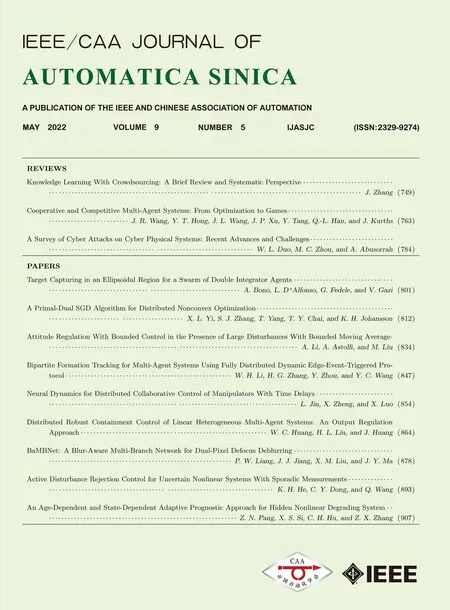Fixed-Time Cooperative Tracking for Delayed Disturbed Multi-Agent Systems Under Dynamic Event-Triggered Control
Jian Liu,, Yongbao Wu,,Mengwei Sun, and Changyin Sun, Senior
Dear editor,
Recently, researchers have obtained many new results about the multi-agent systems (MASs) [1]–[3]. In [1], the fixed-time cooperative control (FTCC) algorithm of linear MASs with matched disturbances was proposed. The nonholonomic chained-form dynamics case was considered in [2]. In [3], the output tracking problem with data packet dropout was solved for high-order MASs.Moreover, delay frequently occurs because of the non-ideal data transmission [4], and the corresponding FTCC algorithm of MASs with delay was given in [5].
However, the above results required continuous updates of controllers. An event-triggered control (ETC) was presented to solve the consensus problems [6]–[10]. In [7], the lossy sensors and cyberattacks were considered for the MASs. In [8], a new distributed ETC was developed for the heterogeneous linear MASs. Furthermore, the FTCC problem was solved for the discrete-time nonlinear MASs with constraints via neural-network-based ETC control in [9]. In[10], the output consensus problem was addressed for the nonlinear MASs under unknown control directions. In addition, some followup studies have employed a dynamic ETC for FTCC [11]–[17]. In[11], a new formation protocol was proposed as required under the dynamic ETC. In [12], the dynamic ETC algorithm can guarantee the agents converge exponentially to the average consensus. Moreover,the formation-containment control problem was addressed in [13].Furthermore, a new bandwidth-aware dynamic ETC scheduling algorithm was applied to the automated vehicles in [14]. In [15], a new framework of cooperative control was developed for MASs based on fault-estimation-in-the-loop. In [16], the dynamic ETC algorithm was applied to industrial systems based on reinforcement learning, and more control algorithms and applications of dynamic ETC were given in [17].
Considering the FTCC with the ETC, there are some good results[18], [19]. In [18], the dynamic ETC was considered for the linear MASs to guarantee finite-time consensus. In [19], fixed-time ETC problem of leader-follower MASs was considered, and a new selftriggered scheme was developed. However, the abovementioned studies need continuous listening. Hence, some new ETC strategies were designed in [20]–[23]. In [20], the FTCC consensus was obtained via ETC, and the input delay was considered in [21].Moreover, the output-based FTCC algorithm was developed in [22].Furthermore, the dynamic mechanism was adopted in [23]. In addition, the self-triggered scheme was presented in [24], and the dynamic mechanism was not considered both in the ETC and selftriggered scheme, which may lead to more triggering times.
Motivated by these existing literature, we investigate the FTCC problem of delayed leader-follower MASs subject to external disturbances via dynamic ETC. However, the dynamic ETC implies less information exchange. Hence, the difficulty is how to obtain the FTCC when the dynamic ETC is considered. The contributions are listed as follows. First, different from the leaderless FTCC results based on ETC [18], [21]–[23], we additionally consider situations that include a dynamic leader. Second, compared with the triggering mechanism in [19], [20], [24], a new dynamic ETC mechanism is designed herein, which can effectively reduce triggering times under the same convergence rate. Third, the consensus tracking can be reached in a finite time under arbitrary initial conditions even with input delay and external disturbances. Furthermore, few results have been reported for the practical FTCC problem for delayed leaderfollower MASs via dynamic ETC hitherto.




Fig. 1. The communication graph.

Fig. 2. Trajectories of the MASs.

Fig. 3. Tracking errors under the dynamic Zeno-free ETC.

Fig. 4. Triggering instants of six followers.


Fig. 5. The evolution of Ξ i(t).
Conclusions: The FTCC problem is addressed for the delayed disturbed leader-follower MASs under dynamic ETC. For the FTCC,the upper bound of the convergence time can be specified by choosing appropriate controller parameters, which is independent of the initial conditions. Compared with the traditional static ETC, the dynamic ETC can effectively reduce triggering times.
Acknowledgments: This work was supported in part by the National Natural Science Foundation of China (62103099,61921004), and the Natural Science Foundation of Jiangsu Province of China (BK20210214).
 IEEE/CAA Journal of Automatica Sinica2022年5期
IEEE/CAA Journal of Automatica Sinica2022年5期
- IEEE/CAA Journal of Automatica Sinica的其它文章
- Attitude Regulation With Bounded Control in the Presence of Large Disturbances With Bounded Moving Average
- A Primal-Dual SGD Algorithm for Distributed Nonconvex Optimization
- Knowledge Learning With Crowdsourcing:A Brief Review and Systematic Perspective
- Target Capturing in an Ellipsoidal Region for a Swarm of Double Integrator Agents
- A Survey of Cyber Attacks on Cyber Physical Systems: Recent Advances and Challenges
- Consensus Control for Multiple Euler-Lagrange Systems Based on High-Order Disturbance Observer:An Event-Triggered Approach
